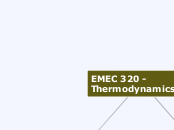EMEC 320 - Thermodynamics
First Law of Thermodynamics
Open Systems
(Control Volume Approach, Constant Volume)
This is how you analyze systems that have mass flowing in or out.
Examples: nozzles, diffusers, pumps, turbines, compressors, heat exchangers, mixing chambers, etc.
Energy Equation,
DEcv/Dt=Qdot-Wdot+Sum_e(mdot*(h+ke+pe))-Sum_i(mdot*(h+ke+pe))
Steady Systems
Single Inlet/Single Exit
q+h_i+ke_i+pe_i=w+h_e+ke_e+pe_e
Nozzle/Diffuser
Throttling Devices/Valves
Turbines/Expanders
Compressors/Fans
Pumps
Heater/Cooler/Boiler
Pipes/Ducts
Multiple Inlets/Exits
Heat Exchanger
Mixing Chambers
Transient Systems
Filling or Emptying a Tank
Closed Systems
(Control Mass Approach, Constant Mass)
This is how you analyze systems that have no mass leaving or entering the system.
Examples: piston cylinders, balloons, closed tanks, rigid tanks.
Energy Equation
/Delta E = Q - W
Total Energy, \Delta E
Potential Energy, \Delta PE
Kinetic Energy, \Delta KE
Internal Energy, \Delta U
If ideal Gas
\Delta u = C_v0*\Delta T
If multi phase (water, refrigerant, or ammonia)
Use tables
Compressed Liquid
P>Psat
T<Tsat
u<uf
v<vf
s<sf
If no compressed liquid table:
u~uf(at T)
(ditto for v, s, & h)
Saturated Liquid
P=Psat
T=Tsat
u=uf
(ditto for v, s, & h)
Saturated Mixture
P=Psat
T=Tsat
u=uf+x*ufg
(ditto for v, s, & h)
Saturated Vapor
P=Psat
T=Tsat
u=ug
(ditto for v, s, & h)
Superheated Vapor
P<Psat
T>Tsat
u>ug
v>vg
s>sg
If Solid or Liquid (no phase change)
\Delta u=C*\Delta T
Heat, Q
Types
Conduction
Convection
Radiation
Usually this is given or it is what you are finding
Work, W
Types
Boundary Work
When boundary is moving (volume changes through the process), W=\int P dV
Isobaric, constant pressure
P=C
Isothermal (constant temperature) and ideal gas,
P=mRT/V
Polytropic,
P=C/V^n
Linear,
P=mV+b
Other (usually given or what you are finding)
Shaft
Electrical
Chemical
Second Law of Thermodynamics
Closed Systems
(Control Mass Approach, Constant Mass)
This is how you analyze systems that have no mass leaving or entering the system.
Examples: piston cylinders, balloons, closed tanks, rigid tanks.
Entropy Equation,
S2-S1 = \int delta Q/T + Sgen
Entropy Change, s2-s1
Substance Types
when phase changes,
use tables
ideal gas,
(s2-s1)=Cp0*ln(T2/T1)-R*ln(P2/P1)
solids and liquids (no phase change),
s2-s1=C*ln(T2/T1)
Type of process
Cycle, s2-s1=0
Process, s2-s1~=0
Heat transfer, \int delta Q/T
if adiabatic,
\int delta Q/T=0
if isothermal,
\int delta Q/T=Q/Tsystem
Entropy Generation, Sgen
if reversible,
Sgen=0
if irreversible,
Sgen>0
Also if irreversible....
(S2-S1)=Q/Tsurr + Sgen (universe)
Open Systems
(Control Volume Approach, Constant Volume)
This is how you analyze systems that have mass flowing in or out.
Examples: nozzles, diffusers, pumps, turbines, compressors, heat exchangers, mixing chambers, etc.
Entropy Equation
Sum(mdote*se)-Sum(mdoti*si)=\int delta Qdot/T +Sgen
Steady Systems
Single Inlet/Single Exit,
se-si=\int q/T + sgen
Entropy change,
calculate the same way as closed systems
Heat Transfer,
\int q/T
Can only calculate if you know how T changes through the device or process.
Isothermal,
\int q/T = q/T
Adiabatic,
\int q/T=0
Entropy Generation, sgen
Reversible, sgen=0
Irreversible, sgen is positive
Multiple Inlets/Exits
Transient Systems
Emptying/Filling a Tank
Cycles
Heat Engine
Thermal Efficiencies
Actual Efficiency,
\eta_he=W/Qh
Carnot (ideal) Efficiency,
\eta_he=1-TL/Th
Heat Pump
Coefficient of Performance
Actual COP,
beta_hp=Qh/W
Carnot (ideal) COP,
beta_hp=Th/(Th-TL)
Refrigerator
Coefficient of Performance
Actual COP,
beta_ref=QL/W
Carnot (ideal) COP,
beta_ref=TL/(TH-TL)
Conservation of Mass
Closed Systems
(Control Mass Approach, Constant Mass)
m1=m2
\Delta m = 0
Open Systems
(Control Volume Approach, Constant Volume)
Steady
One inlet/ one exit
mdoti=mdote
Multiple inlets and exits
Sum(mi)=Sum(me)
Transient
